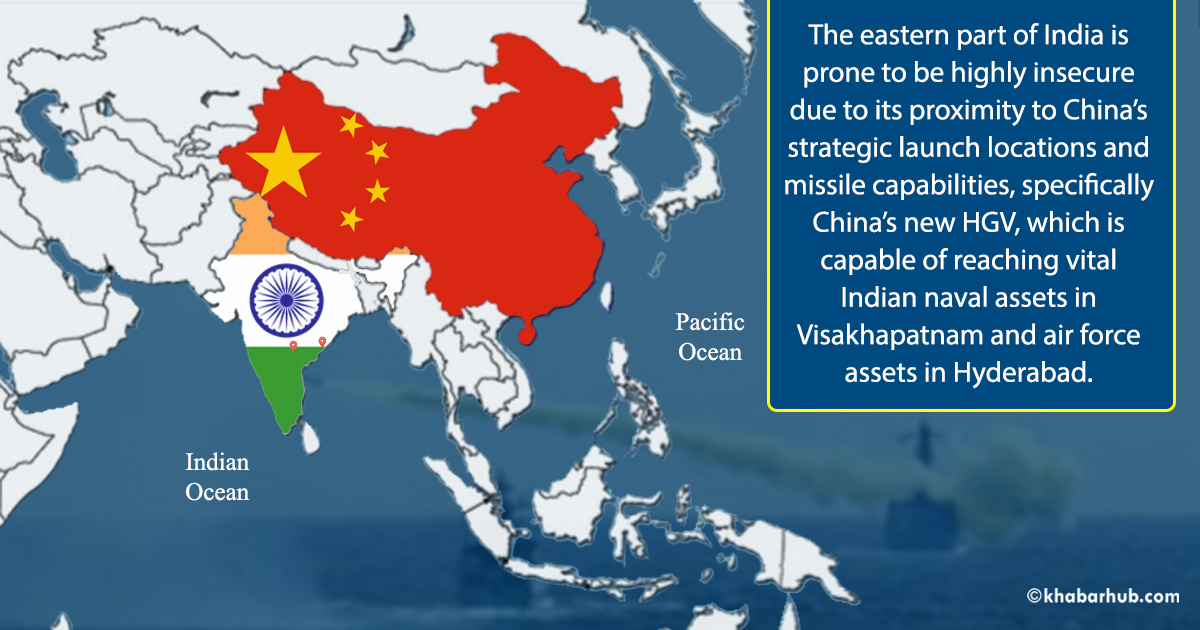By overcoming the challenge of decoherence of entangled photons in the turbulent atmosphere over a long distance, China can construct “quantum radar” to locate stealth objects at great distances—potentially thousands of kilometers.
Quantum radar can unmask stealth fighter aircraft and stealth missiles at long ranges, essentially rendering stealth technology obsolete, including “cyber stealth” that causes virtual disappearance of aircraft in radar by an onboard sophisticated software program that nullifies the image of aircraft in the opponent radar network systems.
China’s Indo-Pacific Maritime Strategy in Sri Lanka
Sino-Sri Lankan defense relations were established during the presidency of Mahinda Rajapaksa. From Beijing’s perspective, the Liberation Tigers of Tamil Eelam (LTTE) terrorist organization was a potential threat and hindrance to China’s future investments in Sri Lanka.
When the civil war persisted in Sri Lanka, the United States declared the LTTE as a deadly terrorist organization, hoping to curb its terrorist attacks and strangle its global criminal network.
Additionally, the LTTE’s sea control capability irked China. In April 2007, Sri Lanka signed an agreement with China to purchase the 37.6 million USD worth of weapons, including Jian fighter jets, antiaircraft guns, and 3D surveillance radars.
In the final years of the island’s civil war, China delivered weapons to warehouses in Galle, on the southern coast of Sri Lanka. These were immediately distributed to battlefields in the northeastern part of the island to support the Sri Lankan military.
China granted 1564 million Sri Lankan Rupees to construct an auditorium at the Sri Lanka Military Academy at Diyathalawa. In addition, Sri Lanka procured six MA-60 aircraft from China, worth of 105.4 million USD.
When the civil war persisted in Sri Lanka, the United States declared the LTTE as a deadly terrorist organization, hoping to curb its terrorist attacks and strangle its global criminal network.
The United States provided more military equipment to improve Sri Lanka’s maritime security against the LTTE, including sophisticated maritime radar and training Sri Lankan soldiers counterterrorism tactics in Sri Lanka.
However, according to Beijing, it was China’s aid that led to the annihilation of LTTE and secured China a position for preferred partnership in future investments.
China influenced Sri Lanka through infrastructure development projects, offering economic “support” in the form of loans, which instead of helping the island rebuild on a stable financial foundation, seduced Sri Lankan leaders into a “debt trap.”
Then, when the Sri Lankan government was unable to make payments, China took over its assets to establish its MSR infrastructure project in Sri Lanka.
The construction of the Hambantota port commenced in 2008. By 2010, Beijing had invested 1.5 billion USD in the project. In December 2017, Sri Lanka, unable to make its payments on the port, handed over the Hambantota Port to China for 99 years.
Additionally, Sri Lanka allowed China to construct special economic zones. The strategic location of this port is only a few nautical miles from the main sea lane of the MSR in the Indian Ocean, which connects the Straits of Malacca to China.
Moreover, another Sino–Sri Lankan venture, the Colombo Port City Project (CPCP) would be a transit trade hub for China in the Indo-Pacific region, and once again poses a serious debt trap for the island.
Sri Lanka decided to move its Southern Naval command to Hambantota Port to protect its special economic zone in the southern province of Sri Lanka.
Though, currently, it is used as commercial port, in the future, the Hambantota port could act as a naval dockyard for China in the Indian Ocean.
This would give China an easy means to move its fleet in the Indian Ocean very near to India’s sphere of influence in the southern part of India, posing a serious security threat to southeastern India.
Moreover, another Sino–Sri Lankan venture, the Colombo Port City Project (CPCP) would be a transit trade hub for China in the Indo-Pacific region, and once again poses a serious debt trap for the island.
China’s Indo-Pacific Strategy in Pakistan
China is developing a China–Pakistan Economic Corridor (CPEC) as a BRI infrastructure development project. India has long objected to the CPEC, as a portion of the project’s route passes through Pakistan-occupied Kashmir.
Additionally, China has built the largest deepwater seaport at Gwadar, Pakistan, as a part of the SLOCs for the MSR.
To contain China, India built Chahabar Port in Iran on the Gulf of Oman, as part of an India–Iran–Afghanistan partnership.
To secure the Gwadar port, China decided to build an overseas naval base in Jiwani, near Gwadar port, in Pakistan’s Balochistan province. The strategic location of this naval base places it near both Chahabar and Gwadar.
India tested the nuclear-capable Agni-V ICBM, which has a strike range of 5,000 km and is capable of reaching the Chinese mainland. To deter India’s missile development, China provides technical assistance to Pakistan for its missile development programs.
Aside from the development of infrastructure projects in Pakistan, China provides conventional weapons, including warships, fighters, short-range missiles, and diesel submarines to Pakistan, which serves to contain India, China’s giant competitor on the Asian continent.
China sold Pakistan 48 units of Wing Loong II medium-altitude long-endurance multirole drones, which are designed to carry air-to-surface missiles and laser-guided bombs.
This multi-role drone can be utilized for combat and surveillance operations against India. Additionally, China provides military support to Pakistan to maintain regional strategic stability, which protects China’s strategic plan in Pakistan for its BRI project.
India tested the nuclear-capable Agni-V ICBM, which has a strike range of 5,000 km and is capable of reaching the Chinese mainland. To deter India’s missile development, China provides technical assistance to Pakistan for its missile development programs.
Pakistan is engaged in developing MIRVs and, in January 2017, successfully conducted its first test launch of its nuclear-capable Ababeel surface-to-surface MRBM with MIRV.
To identify the missile, high-quality imaging optics are essential for gathering visual information of missile from its launch to different phases of flight and reentry of warhead into the atmosphere.
This optical tracking system with an integrated telescope will track the MIRV at a different phase of flight and trace the trajectory of the terminal phase projection of its warheads.
The tracking system is an essential component to accelerate the missile development program to support Pakistan’s program.
China sold optical tracking and measurement systems to Pakistan that were developed by the Chinese Academy of Sciences’ Institute of Optics and Electronics.
China’s assistance will accelerate Pakistan’s missile developments, which inevitably raise security threats to India and help Pakistan to monitor India’s space defense programs.
North Korea’s Missile Threats in the Indio-Pacific Region
In addition to China’s rising missile threat, Sino–North Korea relations also threaten regional stability in the Indo-Pacific.
Although, Beijing condemns Pyongyang’s nuclear arms and missile tests, both countries maintain diplomatic relations under strain.
China calls for lifting international sanctions on North Korea to avoid the collapse of Kim Jong-un’s regime, because China’s investments in the Korean Peninsula depend on North Korea, Pyongyang’s political and economic stability is an important concern for China.
In addition, North Korea’s financial requirements depends on Beijing’s aid. Beyond this, both countries want to deter the US presence in the Korean Peninsula.
North Korea’s commitment to developing long-range nuclear-capable missiles and IRBMs pose security threats to the countries and military assets in the Indo-Pacific Region.
The US military’s demoployment of the Terminal High Altitude Area Defense (THAAD) ballistic missile interceptor in South Korea hinders North Korea and Beijing’s ballistic missile tests.
Beijing’s goal in leveraging its influence in North Korea is for a quid pro quo to weaken US alliance in this region.
On May 2017, North Korea successfully tested its Hwasong-12 mobile intermediate-range ballistic missile (IRBM), which has a maximum strike range of 4,500 km.
When fully operational, this missile will have the capability of reaching northeastern India, the northern part of the Bay of Bengal, and the western entrance to the Straits of Malacca if it is strategically operated from South Hwanghae Province in western North Korea.
Furthermore, North Korea developed long-range nuclear-capable missiles, testing two Hwasong-14 (KN-20) ICBMs in July 2017, which traveled on highly lofted trajectories that over the Sea of Japan, east of North Korea.
These ICBMs have a strike range of 10,000 km, enabling Pyongyang to strike India and as far away as Hawaii, including the US Pacific Missile Range Facility, Barking Sands.
North Korea’s commitment to developing long-range nuclear-capable missiles and IRBMs pose security threats to the countries and military assets in the Indo-Pacific Region.
Are India–Indonesia Bilateral Relations a Game Changer in Indo-Pacific Region?
On 29–30 May 2018, Indian Prime Minister Narendra Modi visited Indonesia. During his visit, Modi and Indonesian president Joko Widodo discussed the views of two countries regarding maritime cooperation for promotion of peace, and economic development (including defense manufacturing) in the Indo-Pacific.
The bilateral relationship between these two countries and the creation of a naval base for India at Sabang Island represent a significant strategic deterrent and vulnerable choke point to China in the Straits of Malacca.
Sabang lies at a strategic location near the straits, meaning Chinese vessels would have to pass through Indian Navy–controlled waters in the Andaman Islands.
Sabang’s port is ideal for military vessels, including submarines, serving as a naval dockyard for India and Indonesia to establish a combined naval base in this region.
India’s naval base in the Andaman Islands and maritime involvement in Sabang Port will create a vulnerable choke point for China to access the western approach to the Straits of Malacca in the Indian Ocean, potentially forcing China to seek alternate sea lanes of transportation for its trade and energy requirements.
One alternative might be the proposed Kra Canal in Thailand, which, if realized, would connect the Gulf of Thailand with the Andaman Sea.
Conclusion
China’s commitment to develop new naval, avionics, missiles, direct energy weapons, artificial intelligence technologies and advanced materials for state-of-art technology and quantum communications will raise China’s comprehensive (land, air, maritime forces, and cyber space) defense capabilities and further Beijing’s intent to become a global superpower.
The advances also strengthen China’s abilities to protect its SLOCs in the Indo-Pacific region and expand its blue water naval capabilities—including aircraft carriers, nuclear-powered submarines, and SSBNs—and improve its global trade and hunt for energy resources.
The eastern part of India is prone to be highly insecure due to its proximity to China’s strategic launch locations and missile capabilities, specifically China’s new HGV, which is capable of reaching vital Indian naval assets in Visakhapatnam and air force assets in Hyderabad.
Besides weapons developments, China’s military strategy in other countries, particularly in Sri Lanka and Pakistan, also plays a vital role in deterring its adversaries in the region.
To strengthen India’s maritime security, it is necessary to analyze China’s strategy in Sri Lanka and Pakistan. In the future, the strategic location of these two countries supports China’s ability to project immediate offense force against India, greatly deterring India’s security strategy in Asia and the Indian Ocean region.
North Korea’s threat in the Indo-Pacific is also a great concern for the United States, its allies, and friends.
The rise of China as a superpower will govern the geo-economics and geopolitics of the BRI in the Indo-Pacific.
Thus, it is necessary for other actors in the region to seek balance for the trade and military power in the region to assure a free-and-open Indo-Pacific region.
Security Implications and Policy Prescriptions
The eastern part of India is prone to be highly insecure due to its proximity to China’s strategic launch locations and missile capabilities, specifically China’s new HGV, which is capable of reaching vital Indian naval assets in Visakhapatnam and air force assets in Hyderabad.
China’s advanced ballistic missile technology challenges India’s ability protect its land and maritime domains. It is appropriate to incorporate Indian navy battleships with free-electron lasers to defend against existing and future ballistic missile threats.
The DF-26 is also capable of reaching any portion of India’s eastern coast—as is the JL-2, which could launch from anywhere in Chinese waters.
China’s surveillance activity in the South Pacific from its optical tracing system in Vanuatu, Beijing’s ensnaring of Sri Lanka and control of that island’s ports, and the PLAN’s increasing maritime activity in the Indian Ocean endangers southeastern India.
India’s naval capability should be increased in eastern and southeastern of India to deter the Chinese maritime threat.
Doing so will also ensure the maritime security of the Bay of Bengal region. The Eastern Naval Command at Visakhapatnam is insufficient to protect the entire eastern coast of India.
We suggest the establishment of an additional naval command at Chennai and two new naval-air bases in that eastern naval command to confront Chinese threats to Chittagong Port in Bangladesh, Sittwe Port in Myanmar, and the future Kra Canal region.
The exiting Indian Air Force training base at Kodiyakarai should be upgraded to a Naval Air Base, as it is a strategically important location for containing Sri Lanka’s Palaly Military Base formerly Jaffna International Airport, which was recently converted to a Sri Lankan Air Force base.
Other naval-air bases would be appropriately located between Thoothukudi and Kanyakumari in the Indian state of Tamil Nadu to confront tactical multidirectional attack and undermine the first-strike capability of China.
Also, the Ministry of Defense must strengthen INS Parundu naval air base at Uchipuli, (Tamil Nadu), and Thanjavur Air Force Station (Tamil Nadu) to thwart the growing Chinese presence near the Sri Lankan island of Katchatheevu and Northern Province of Sri Lanka.
To deter China’s maritime strategy in Thailand, India must establish a combined naval base with Thailand in Surat Thani province to strengthen India’s future maritime security and to choke the PLAN’s fleet in the Indian Ocean region.
It is appropriate to establish integrated three-layer missile defense in the northeastern and southeastern parts of India to strengthen missile defense against security threats from the Chinese mainland, South Pacific, and Indian Ocean.
We also call for the establishment of a multitier missile defense along with direct energy weapons in northern India to deter missile threats from China’s western theater command.
These latter measures will also defend the Eastern Naval Command and northern part of the Bay of Bengal from the threat of China’s new HGV.
China’s advanced ballistic missile technology challenges India’s ability protect its land and maritime domains. It is appropriate to incorporate Indian navy battleships with free-electron lasers to defend against existing and future ballistic missile threats.
To deter against China’s stealth-breaking Quantum technology, India’s stealth aircraft must be improved—possibly through the use of multicolor entangled photon cloaking with additional quantum-state processes—to attain air superiority over China in the Indo-Pacific.
To deter China in Sri Lanka, we propose establishing joint air force bases in Trincomalee and Batticaloa, creating greater defense cooperation between Indian and Sri Lankan Air Forces and weaning the island from its dependence on China and Pakistan.
Moreover, India and the United States must put diplomatic pressure on Colombo to reach a federal solution to the island’s prolonged ethno-religious conflict.
Finally, we argue for the need to develop an architecture of comprehensive security not just for balancing but collective security measures for maintaining order and security in the Indo-Pacific region by India and its allies.
(Thangavel K. Balasubramaniam is a doctoral candidate at the Department of Politics and International Studies, Pondicherry University, India; and Ashok Kumar Murugesan is a doctoral candidate at the Department of Physics, Pondicherry University, India)









Comment